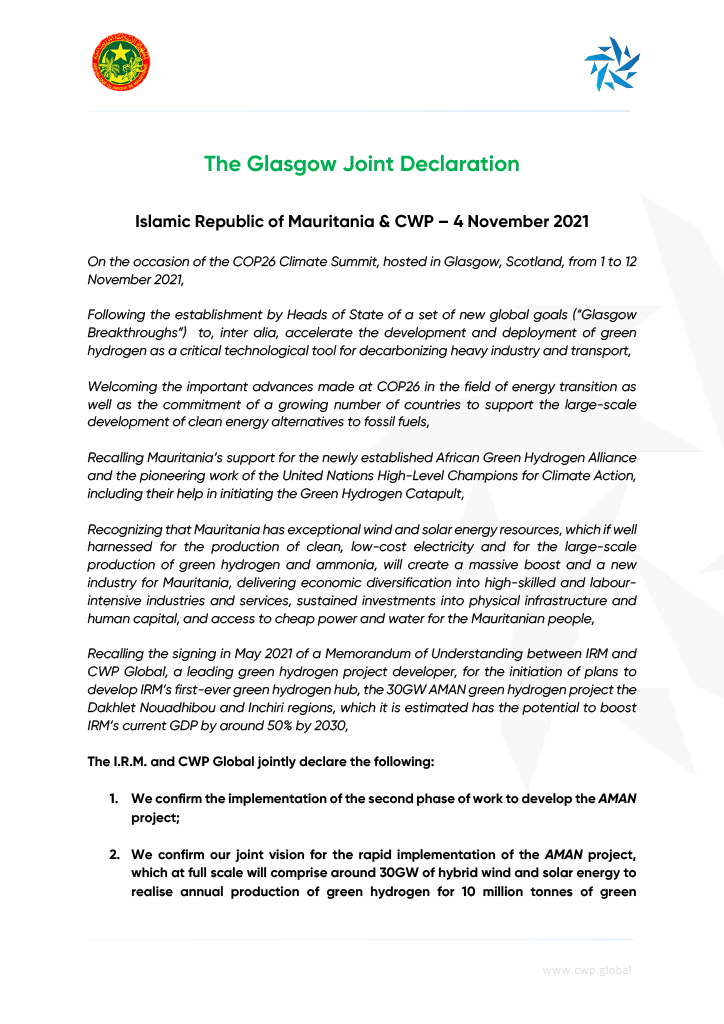Mauritania ammonia mega-project enters next phase
By Julian Atchison on November 10, 2021
This week in Glasgow, CWP Global and the Mauritanian government announced a timeline & production capacity for the 30 GW project. The partners also call for the development of associated decarbonisation projects in Mauritania, helping to develop a local hydrogen & ammonia economy.
Also at Glasgow, Mauritania also became a founding member of the African Green Hydrogen Alliance: a group of six countries aiming to kick start millions of tonnes of renewable hydrogen production in Africa by developing regulatory, financing and certification structures to promote the new industry.
The Islamic Republic of Mauritania and CWP Global jointly declare the following:
…
2. We confirm our joint vision for the rapid implementation of the AMAN project, which at full scale will comprise around 30GW of hybrid wind and solar energy to realise annual production of green hydrogen for 10 million tonnes of green ammonia, which will enhance IRM’s food security, access to green fuels and a massive new export industry; and
3. We agree to pursue the following timetable of milestones for development of the AMAN project:
A. Completion of feasibility studies by December 2022
B. Environmental and social impact studies by June 2023
C. Completion of the FEED by December 2024
D. Pursue financing agreements, FID & commencement of construction in 2025
E. Production commences before 2030…
5. At the same time, we encourage the development of other associated projects in Mauritania, in the fields of desert agriculture, hydrogen-based transport, iron processing and other industries requiring abundant amounts of energy and water, which will allow us – all together – to contribute to the decarbonization of our planet as well as to continue developing the necessary technologies.
The Glasgow Joint Declaration from CWP Global and the Islamic Republic of Mauritania, 4 Nov 2021
The Aman P2X project
Announced in June, the Aman project will be located on a 8,500 km2 desert site in the country’s north and be powered by 30 GW of wind and solar capacity. Aman is a mega-project in its own right, but the sheer scale of renewable hydrogen & ammonia production required to decarbonise key global sectors was laid out at the project launch in the form of “Aman equivalents”:
In order to limit global warming to 1.5C, global emissions will need to be reduced quickly over the next decade en route to net zero emissions by around 2050. This will require the application of green hydrogen solutions in hard-to-abate sectors, and in tandem with mass electrification.
Major sectors that will need green hydrogen include :
• Green steel production – would require 80 AMAN equivalents. This transition is not far away – with a carbon price of $70, it could happen today.
• Green long-range shipping will require the equivalent of 50 AMANs for current needs – assuming projected growth, this will be closer to 70.
• Decarbonized Agriculture – to transition from today’s fossil-fuel-based ammonia production, decarbonized fertilizer produced using green ammonia would require around 15 AMANs. Projected fertilizer demand in 2050 will be much higher given estimates of a 10B global population.
Aman project press release from Mauritania’s Ministry of Petroleum, Mines & Energy, 28 May 2021
